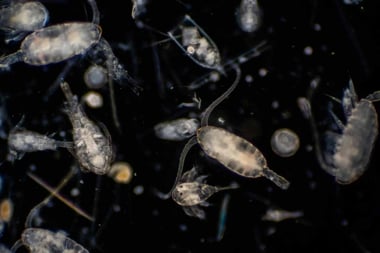
The biomimicry movement has taken the lotus effect and applied it to natural examples to create sustainable, innovative designs inspired by nature.
In Asia the lotus flower symbolizes purity of body, speech, and mind. In nature, the lotus rises above dirty water to stand tall, vibrant, and clean above murky depths. Perhaps it is this self-cleaning property–possibly an evolutionary defence mechanism against fungal attacks–that contributes to this flower’s association with purity.
About 10 years ago, in 1997, a German botanist named Wilhelm Barthlott took a good, close look at lotus leaves to try to solve the self-cleaning mystery. He found that the leaves are covered in a nanoscopic waxy texture that prevents both water and dirt from clinging to the leaves’ surface. Because of this texture, no more than 2 to 3 percent of the water molecules come into contact with the leaf surface. Water rolls off. Dirt rolls off with the water. Nothing sticks.
A Solution Surfaces
Today companies are developing all kinds of products using the “lotus effect.” Some products may cause problems by possibly releasing harmful contaminants (paints, spray coatings, fabric treatments); but others could save the environment. Self-cleaning products such as textured plastics, road and building materials, and glass could reduce or eliminate the need for water and chemicals and increase safety and insulation factors. Textured, reusable, self-cleaning plastic dishes would repel contamination. Roads and buildings made from water-resistant materials would be cleaner and safer.
An especially exciting possibility is lotus leaf-textured glass, which has the same transparency of normal glass, but repels water and dirt. Buildings made with this type of glass could cut down on the amount of chemicals and water normally used for cleaning. We could make more fuel-efficient vehicles with lotus leaf-textured windshields that experience considerably less wind friction. And nobody would have to wash windows. We’d have more time to practice our yoga (working up to the lotus position).
Inspired Design
In addition to discovering how lotus leaves self-clean, Barthlott also provided a perfect example of the newly named scientific method called biomimicry. Described by Janine M. Benyus in her book Biomimicry: Innovation Inspired by Nature (Harper Collins, 2002), biomimicry is a relatively new discipline in which scientists and other problem-solvers study nature’s best ideas and then imitate these designs and processes to solve human problems. Although biomimicry may be a new name for it, the practice of turning to nature for answers is centuries old.
One of the first and most famous examples of biomimicry was seen by the world in 1851. Joseph Paxton, an English gardener and architect, was inspired by nature for his design of the Crystal Palace for the Great Exposition in London’s Hyde Park. In his greenhouses, Paxton was able to grow Amazonian Victoria Regia water lilies (Victoria amazonica) with leaves that were 4.5 feet (1.4 metres) wide. These leaves inspired the design of the Victoria Regia House conservatory, and then later, the Crystal Palace.
In recent years, the biomimicry movement has evolved to focus on sustainable innovation and design inspired by nature. Recent real-world examples of innovation inspired by biomimicry can be found all around us. Biologists are looking at termite mounds to see how temperature and humidity is regulated so efficiently within them. From this research, scientists think that we could learn how to design buildings which don’t require cooling systems.
Other biologists are studying life-enhancing innovations such as how bats use echolocation to navigate without eyesight, so we can build a cane for the visually impaired. Scientists at MIT have been inspired by the dual-purpose texture of beetles’ shells–the bumpy parts collect water droplets, the smooth parts funnel the water to the beetles’ mouths–to develop new kinds of antibacterial coatings.
Biomimicry Groups
Online, there are two major innovative biomimicry groups: The Biomimicry Institute (with Janine Benyus as president), which can be found at biomimicryinstitute.org, and the Biomimicry Guild (biomimicryguild.com). Both are portals for biologists to provide design inspiration, practical knowledge, tools, and strategies, and to collaborate to help build sustainable, life-friendly solutions.
It seems ironic that we may increasingly look for solutions to our man-made problems from the very planet we are slowly destroying. According to the Biomimicry Institute, that may be the best place to look. “The core idea is that nature, imaginative by necessity, has already solved many of the problems with which we are grappling.”




